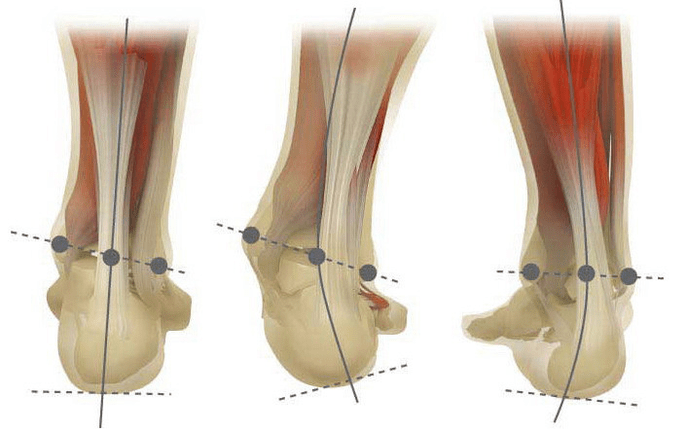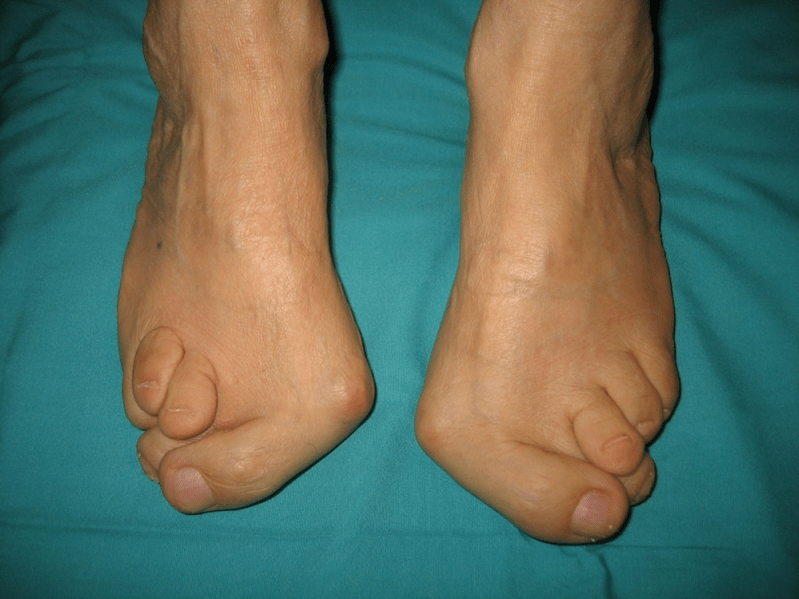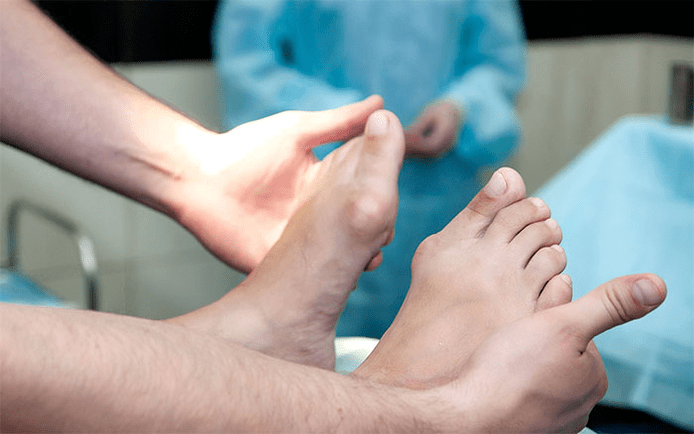The deformation of the feet valge is usually congenital. However, in some cases, with paralysis, traumatic injuries, they may already appear in the mature period of life. The main symptoms of pathology are pain in the feet area and muscles at the bottom of the leg, a visible violation of the shape of the feet, as well as a change in the march. The diagnosis of the disease is carried out using a clinical examination, X -rays, electromyography, etc. The treatment includes conservative and surgical methods. However, adequate effectiveness is observed only in reconstructive operations.
What is this ailment?

The deformation of the valgo is the curvature of the foot, characterized by the flattening of its longitudinal arc. In general, the internal edge of the foot is lowered ("drops"), and the heel results.
The foot of a person, by virtue of its location, acquires the pressure of the entire mass of the human body. For this reason, it has a special anatomical structure, which allows depreciation, balance and stabilizing movements. However, an important component for the implementation of these tasks is the correct stop form.
Today, the most important problem of traumatology and orthopedics is the deformation of the feet. The meeting is estimated at 30-58%, where 2/3 of cases represent congenital disorders.
The pathology is largely significant, because it covers all the age groups of the population and also helps to curve the spine, the early development of osteochondrosis and osteoarthritis of the joints of the lower extremities.
When you take your feet (if you look at them from behind), a deformation similar to X at the ankle level is formed: the ankles are in contact, while the heels are at a distance of 5-6 centimeters from each other.
Most of the time, the pathology is of congenital nature and is diagnosed in children in the hospital (or immediately after the beginning of walking). A similar condition adjusts up to 5 years, after which (in the absence of adequate treatment), a child develops flat feet.
Why does it arise?
It is believed that the main reason for the appearance of the deformation of Valgo del Pie is an inappropriate function of the posterior tibial muscle or the weakness of the ligament apparatus.
Today other factors are distinguished in the development of pathology:
- Congenital abnormalities with the incorrect location of the bones of the feet or shortening of the tendons (vertical arbitrar bone, short pile tendon);
- Posture disorders when feet deformation compensates for the curvature of the spine;
- Traumatic lesions (fractures of the bones of the feet, lower part of the legs, hips or knees, ruptures of the ligament and tendinous apparatus);
- Paralysis (immobilization) Due to the damage to the nervous system by encephalitis, polyomyelitis, stroke, violation of the cephalorraquidejas foundations for hernias, etc. ;
- Spasm (constant contraction) of the muscles at the bottom of the leg;
- Concomitant diseases: Bone system pathology with vitamin D (rickets), diabetes mellitus, osteoporosis (bone density reduction), altered thyroid and parathyroid glands, etc. ;
- Body weight gain, including rapid weight gain in menopause or during pregnancy.

The development of pathology is also facilitated by incorrectly selected shoes or excessive clubfoot correction in childhood.
GRADE AND STAGE OF THE DISEASE
The severity of pathology (manifestation power) is divided by degrees:
- Light with a vault height of 1. 5-2 centimeters and an angle of inclination of the heel to 15 degrees;
- The average, when the arc is flattened to the first centimeter, and the angle decreases to 10 degrees;
- Heavy at the height of the vault up to 0. 5 cm and the angle of inclination of the heel is 5 degrees.
Depending on the participation of certain structures, the following stages of curvature are distinguished:
- There are no bone deformations, the pain is determined on the internal surface of the ankle (in the posterior tibial muscle fixation area);
- The curvature is light, the heel is slightly rejected;
- The foot is assigned and the deformation is fixed (not correctly corrected);
- The flavors are observed not only in the foot, but also in the articulation of the ankle.
Symptoms
In the first stage, patients are disturbed by periodic pain after prolonged walks or long vertical loads (standing or sitting on the foot). As a general rule, pain syndrome intensifies when walking in incorrectly selected shoes. The next stage of the disease is associated with the appearance of the curvature of the foot: patients in standing position do not depend on the outer edge of the foot, but with their entire area. A slight change in the march is observed.

In the third stage, the protuberance of the defrosted bone (remarkably lower than the ankle on the internal surface of the ankle) is determined, as well as a strong deviation from the heel outside (the patient is based on the inner edge of the heel bone). Advanced feet valge deformation is characterized by a curvature pronounced both of the foot in itself and the ankle joint. Patients complain of severe pain in the muscles at the bottom of the leg, as well as a significant rape of the march: the knees rub each other, while the right and left foot is at a distance.
The severe curvature of the feet is often complicated by the deformation of the spine (scoliosis with different positions of the shoulders of the pelvis), osteochondrosis (damage to the intervertebral disc with the formation of a hernia) or the osteoarthritis (premature wear of the intra -articular cartilage in the lower leg, the knee and the milestone).
How to diagnose?
The diagnosis of foot curvature consists of:
- The clinical inspection, during which the orthopedist detects a decrease in the arches of the foot, the deviation of the heel and the bones of RAM, the visible "disappearance" from the exterior and the protuberance of the internal ankles.
- X -Ray: An affordable and informative method with which you can determine the change in the angles of bone inclination and the linear parameters of your relationship. These indicators are necessary to make a final diagnosis and clarify the degree of deformation.
- The steps registration method aimed at determining the exact functional status of the limb. The method consists in registering the time of the support of individual parts of the foot when performing one step. In the course of the study, the phases of foot bearing are also studied, which reflect the balance of the lower limb muscles.
- Dynamic electromyography, which records the electrical activity of the muscles studied and its dependence on the passage phase.
- Photoplesmography with digital processing that allows you to obtain all standard indicators and determine the type/degree of curvature with high precision.
An additional neurologist consultation (with deformations due to spasms or paralysis), endocrinologist (in the case of diabetes or thyroid/parathyroid gland disorders) and the gynecologist (when the threat) is required. If the curvature of the foot appeared in the context of osteoporosis, densitometry is necessary: the study of bone density.

Treatment
Among the main methods to treat the curvature of the feet, conservative and operational are distinguished. Do not destroy the painful joints with ointments and injections!
Conservative approach
This type of help aims to get rid of the symptoms of the disease, but does not eliminate the root cause of pathology.
The technique includes:
- The use of orthopedic templates to withstand the I Plus bone, the arc of the foot, as well as the elimination of the valge lesions of the medium and the back of the foot;
- Recording: Set the foot and ankle using special adhesive tapes with the proper elasticity. The tape is used throughout the day within 3-5 days, after which they are replaced;
- Sew orthopedic shoes according to individual standards;
- The use of orthosis and other fixing devices on the foot and ankle.
Conservative methods also include physiotherapeutic procedures (ozokerita, paraffin, electrophoresis applications, magnetic effects), massages and a complex of physiotherapy exercises, developed for a specific clinical case. Be careful! Today, most experts prefer surgical treatment methods, because conservative therapy is ineffective (according to statistics, it is useless in 60% of cases).
Surgical intervention
The volume of operation and its type depend on the direct stage of the disease. Therefore, the first degree of deformation of the valgo is treated by butctomy (elimination of the tendon cover for the correction of the general tension) or the osteotomy (dissection) of the heel to return to the anatomically correct position. In the second stage of the development of the disease, the transplantation of the fingers tendon curves is used. This intervention is generally carried out in the heel dissection fund or a lobed arthrodesis by RAM (surgical immobilization of the joint between RAM and the scanning bones).
The curvature of grade III requires the arthrodesis of several foot joints at the same time: the lack of more than five cubic cubic and the desired RAM. Such immobilization of three pounds is often complemented by the dissection of heel bone. In stage IV of pathology, reconstructive operations are needed not only in the foot, but also in the ankle. In this case, the instability of the ligament apparatus is adjusted using transplants (of your own body or artificial materials). The volume of operations in the foot itself is the same as with the degree of curvature III.
Recovery period
Rehabilitation includes walking without support in the leg operated for 2 months. At the same time, the patient needs to use removable plaster length of 1. 5 to 3 months. It is recommended to begin active movements in the foot operated after 1, 5 months after surgery. For the third month, a complex of strengthening physical education is introduced. However, later patients are prohibited from walking with potholes and active sports activities. It is worth noting that it is possible to judge the final result of surgery only six months later.
Preventive measures

The prevention of the deformation of the Valgo of the stop includes the following measures:
- Early correction of congenital anomalies with the inadequate arrangement of the bones of the feet or the shortening of the tendon grains (vertical defrost bone, tendon of the short heel);
- Correction of postural disorders (scoliosis, etc. );
- Timely treatment of traumatic injuries (fractures of the bones of the feet, the lower part of the leg, the thigh or the knee joint, the ruptures of the ligament and tendon apparatus);
- The correct rehabilitation after paralysis (immobilization) due to the damage to the nervous system by encephalitis, polyomyelitis, stroke, violation of cerebrospinal roots for hernias, etc. ;
- Spasm relief (constant reduction) of the muscles of the lower leg;
- Therapy for concomitant diseases: Pathologies of the bone system with vitamin D (rickets), diabetes mellitus, osteoporosis (bone density reduction), deteriorated function of thyroid and paratiroid glands, etc. ;
- A decrease in body weight to normal (especially with a rapid increase in weight in postmenopause or due to pregnancy);
- Selection of orthopedic shoes or the use of supiners;
- Moderate correction of the Club piece without treatment with "hypercorrection" -excess -excess that leads to the excretion of secondary feet.
The prevention of disease progression is to use conservative methods and early reconstructive operations. In this case, physical activity is limited to avoid the destruction and curvature of the ankle joints. Remember, the timely treatment of the deformation of the feet valge not only improves the quality of life of the patients, but also avoids the development of osteochondrosis and osteoarthritis of the knee or hip joints.























